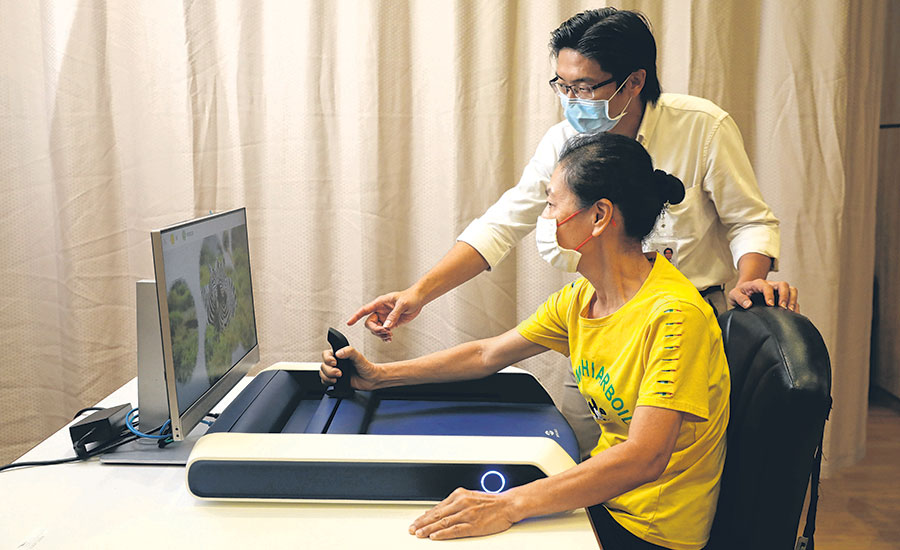 Madam Seet Jeu Luang, 60, who had a stroke in July last year, using the H-Man device yesterday during a media demonstration, under the guidance of Mr Christopher Kuah, principal occupational therapist at Tan Tock Seng Hospital. Madam Seet was one of 10 patients who experienced using H-Man earlier this year to complement the daily hand and arm exercises she did at home. ST PHOTO: ONG WEE JIN
Madam Seet Jeu Luang, 60, who had a stroke in July last year, using the H-Man device yesterday during a media demonstration, under the guidance of Mr Christopher Kuah, principal occupational therapist at Tan Tock Seng Hospital. Madam Seet was one of 10 patients who experienced using H-Man earlier this year to complement the daily hand and arm exercises she did at home. ST PHOTO: ONG WEE JIN
The Straits Times (29 October 2020)
It helps them rebuild their arm strength, and can be used at home or in hospitals
A portable robotic device that can help stroke patients with their recovery at home was unveiled at a media event at Tan Tock Seng Hospital (TTSH) yesterday.
Aided by the robot, patients can do the repetitive exercises needed to regain control in their arms and build up their strength, without always having to visit a clinic or hospital for sessions with a therapist.
The portable arm rehabilitation robot weighs 14kg and has been named H-Man. Rather than resembling a man, however, the device sits on a table, its joystick-shaped handle connected to a computer screen and a resting pad. It may look simple enough, but HMan is an intelligent device.
It can sense the condition of the patient’s arm in terms of strength, coordination and agility, and automatically adjust assistance or resistance according to his needs when he performs the exercises, which involve playing a game shown on the screen, using the joystick.
In this manner, the patient relearns sensorimotor control so that he can resume daily activities. Furthermore, H-Man will give feedback about the patient’s progress to his therapist, who can monitor recovery remotely. This is particularly convenient amid the Covid-19 pandemic.
During the media launch at TTSH, Dr Asif Hussain, chief executive and co-founder of Articares, the company that is developing HMan, said that the robotic device is used in some hospitals and nursing homes here and overseas, but not at TTSH – although the hospital has plans to incorporate it in one of its post-stroke therapy programmes some time next year.
He said that most robots currently used for rehabilitation purposes weigh up to 70kg and are located at hospitals where their operation is managed by occupational therapists.
These robots are also costly, which makes widespread implementation a challenge.
Stroke is the leading cause of long-term disability, and rehabilitation helps those who have had a stroke relearn the skills they lost when part of their brain was damaged.
CLOSER TO HOME
"The traditional way is to bring the patient to the clinic where you have maybe one hour for the therapy. Anything longer than an hour is difficult as the patient will be fatigued... But if you have something closer to home, maybe you can have 15 minutes in the morning, 15 minutes in the afternoon. ’’
- ASSOCIATE PROFESSOR DOMENICO CAMPOLO, co-founder of Articares, on the benefits of using the H-Man at home.
Associate Professor Domenico Campolo, co-founder of Articares, said the portability of H-Man can make a difference in the use of such technology for post-stroke therapy. “When we started, we really wanted to build something for the home... Our definition of portable was anything that fits in a taxi,” he said.
The Articares founders said HMan can be rented or purchased, but they declined to share the cost. “The traditional way is to bring the patient to the clinic where you have maybe one hour for the therapy.
Anything longer than an hour is difficult as the patient will be fatigued,” said Prof Campolo, who is also director of the Nanyang Technological University (NTU) Robotics Research Centre.
“But if you have something closer to home, maybe you can have 15 minutes in the morning, 15 minutes in the afternoon. It opens up possibilities to try new therapies as well.”
Retiree Seet Jeu Luang, 60, who had a stroke in July last year and has weakness in her dominant right arm, was happy to use H-Man to complement the daily hand and arm exercises she did at home.
She was one of 10 patients who experienced the H-Man that was on loan from Articares at TTSH’s Centre for Advanced Rehabilitation Therapeutics (Cart) early this year. It has since been returned.
H-Man is the result of more than eight years of work by scientists from NTU, in collaboration with rehabilitation physicians and occupational therapists from Cart.
Adjunct Associate Professor Karen Chua, a senior consultant at TTSH’s Department of Rehabilitation Medicine and at NTU’s Lee Kong Chian School of Medicine, led the clinical trials for H-Man from 2014 to 2018.
She said it has demonstrated its efficacy in helping patients improve their upper-limb mobility in combination with conventional occupational therapy, during a clinical trial involving 60 stroke patients undergoing rehabilitation.
“Furthermore, lasting gains up to 19 weeks were observed after training, implying sustainability of the training, and this was associated with high levels of patient safety and self-reported satisfaction in trained subjects,” she said, adding that the therapist will set the training goal for the patient and that the exercises must be prescribed.
When the H-Man trial was completed, the technology was commercialised and spun off into Articares, which is incubated by NTUitive, NTU’s enterprise and innovation company.
TTSH’s principal occupational therapist Christopher Kuah said that H-Man, which can also be used in hospitals, makes repetitive exercises less boring for patients, as they play a game while doing their therapy.